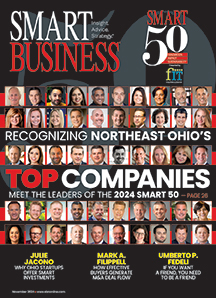Companies like Google, Pandora and Apple sport colorful, hip headquarters that capture who they are and what they do. Now more than ever, business owners of companies of all sizes and sectors are grappling with the changing workplace.
“The way we work is changing, heavily influenced by the freedom technology provides and younger generations that are looking for something else,” says Tracy Sciano Vajskop, associate principal and senior interior designer at Bialosky Cleveland.
“Giving employees choice and control of where to work empowers them and increases engagement. The key to balanced workplace design is a variety of spaces for group work with individual spaces for concentration and thought.”
Smart Business spoke with Sciano Vajskop about the impact your workplace can have on your employees and your brand.
What is programming? How can employers, real estate brokers and advisers benefit?
Programming is a process architects and interior designers use to assess a company’s space needs and goals. It involves data-gathering with surveys, interviews, visioning sessions, workshops and on-site observation.
These tools shed light on how the company and its departments operate, the relationship of internal teams and departments, current space standards, company culture, business goals and challenges.
Programming also addresses the challenges around shrinking, growing, merging and acquiring, which inherently alters a company’s DNA. It offers a framework for what the new space hopes to achieve, and a strategy for how real estate can support those goals.
For instance, if a company has trouble attracting fresh talent, it can be helpful to provide spaces to easily collaborate with co-workers, work cafés for staff to recharge, and quieter, private spaces for individual and small group work.
How can improved space impact companies?
A company’s real estate needs to support the work being done. When anticipating a move, renovation or limited facelift, if leaders self-examine their company culture, processes and protocols, they can be informed and strategic about decisions.
The first inclination may be new carpet, paint and minor reorganization, but if looked at as an opportunity for transformation, then looking beyond the cosmetic can be a turning point for your business.
When Bialosky moved to its new space, the benefits were apparent almost instantly. The old space had been appended over time and was full of divided hallways, locked doors and studios with different vibes and culture. Collaboration space was limited.
The new location is open and everyone sits together on one floor. Efficiency increased and communication among the team happens more naturally. With various ways to meet and gather, collaboration is easier and the culture has been unified.
When making a workplace change, how should the switch be managed?
It is critical to maintain communication with your team. With any change, the more you keep people informed, the easier the process will be. Identify the change agents within your company to help spread the message and support the change.
Give employees the opportunity to voice their opinion, even in the form of a five-question survey. Owners do not have to appease every request, but this can generate ideas, raise lesser known concerns and allows employees to have a voice.
With major changes, such as transitioning to open workstations or a ‘free address system’ where no one ‘owns’ their space, make the business case for change. Explain how it will help processes, efficiencies and ultimately profitability.
What else would you tell those considering changes to their workspace?
No matter the size of the project, you can never start this process too early. Even if your move is a few years away, analyze and set goals upfront. Then, when it is time to look for space and put pen to paper, you already know your needs.
We spend more time awake at work than at home. Working in a space that is visually intriguing, comfortable, functional and reflective of the company’s brand/values contributes to employee engagement. The power of a physical environment influences employee happiness, the ability to attract and retain top talent, and earn new clients. ●
Insights Architecture & Design is brought to you by Bialosky Cleveland

